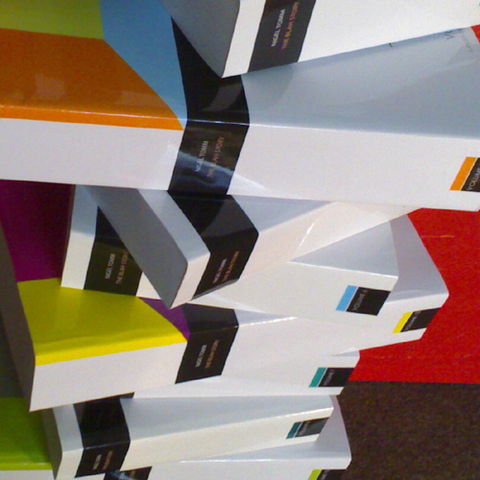Nigel Tomm Publishes the Longest Sentence Which Contains the Longest Word
June 11, 2008 (PRLEAP.COM) Entertainment News
After film adaptations of J.D. Salinger's "The Catcher in the Rye" and S. Beckett's "Waiting for Godot," writer/artist/director Nigel Tomm publishes the longest sentence in literature which contains the longest published word. The sentence is contained in four volumes of Nigel Tomm's novel "The Blah Story," i.e., the sentence occupies volumes 16, 17, 18 and 19, while "The Blah Story, Volume 19" is almost entirely occupied by one word which contains all previously known longest words (except chemical names).The sentence contains 2,403,109 words, 15,403,732 characters (with spaces) or 3,248 pages. "The Blah Story, Volume 19" which is 812 pages long contains only 11 words, one of which 'somewhenot…dingown' consists of 3,609,750 letters. The word means the current day or date between real and imaginable today.
The word contains all previously know longest words the longest of which are: lopado…pterygon (183 letters; it is a fictional dish mentioned in Aristophanes' comedy "Assemblywomen"), Bababa…nuk (101 letters; coined by J. Joyce in "Finnegans Wake"), Taumatawha…tanatahu (85 letters; it is a place name), pneumo…iosis (45 letters; it is a lung disease, this is also longest word in a major dictionary), antidisestablishmentarianism and others.
The 3.6M-letter word is coined by adding different words which end up and begin with the same letter, i.e., the first 34 letters somewhenotodayoundressomecological are coined from words somewhen+(n)ot+(t)oday+(y)ou+(u)ndress+(s)ome+(e)cological.
Before "The Blah Story, Volume 19," the longest coined word belonged to Nigel Tomm, his book "The Blah Story, Volume 10" contains 2,087,214-letter word which means something like 'a girl' or 'a bitch'; this word is not included in the 3.6M-letter word. Theretofore, the longest published sentence in English was written by Nigel Tomm, too, whose book "The Blah Story, Volume 4" contains a 469,375 word sentence (732 pages).
Traditionally, the longest sentence in English literature has been found in James Joyce's "Ulysses" which contains 4,391 words. However this was surpassed in 2001 by Jonathan Coe's book "The Rotter's Club" which contains a sentence 13,955 words long. There is also a Polish novel "Gates of Paradise" written by Jerzy Andrzejewski, and published in 1960, with about 40,000 word sentence. Also, there is a Czech novel that consists of one long sentence (128 pages long) "Dancing Lessons for the Advanced in Age" by Bohumil Hrabal.
In "The Blah Story" Nigel Tomm not only develops abstract literature or algorithmic literature genres, but also introduces literary phase-shifting, i.e., allowing nearly identical phrases at slightly differing lengths to repeat and slowly go out of phase with each other. Nigel Tomm's literary phase-shifting minimalism is made dazzlingly entertaining in "The Blah Story," which is made persuasively engaging textures from repeated phrases in the novel. All "The Blah Story" is based mostly in steady pulse, stasis and slow transformation, and often reiteration of phrases or other textual units such as paragraphs, sentences, and words (with over usage of the word 'blah').
Nigel Tomm is also known as a film director. His five film adaptations: "The Catcher in the Rye," "Waiting for Godot," "Hamlet," "The Brothers Karamazov" and "Oedipus Rex" explore and demolish new absurdism (also neo dada) genre.
Film description at Amazon.com states: "Conceptual film adaptation of "The Catcher in the Rye," directed by Nigel Tomm serves us 75 minutes of pure blue screen, nothing more, nothing less." In Beckett's "Waiting for Godot" film adaptation Nigel Tomm serves us 72 minutes of pure green screen, while Shakespeare's "Hamlet" is 63 minutes of pure white screen, Sophocles' "Oedipus Rex" is 71 minutes of pure red screen and Dostoevsky's "The Brothers Karamazov" is 73 minutes of pure magenta screen, as usual, nothing more, nothing less.
